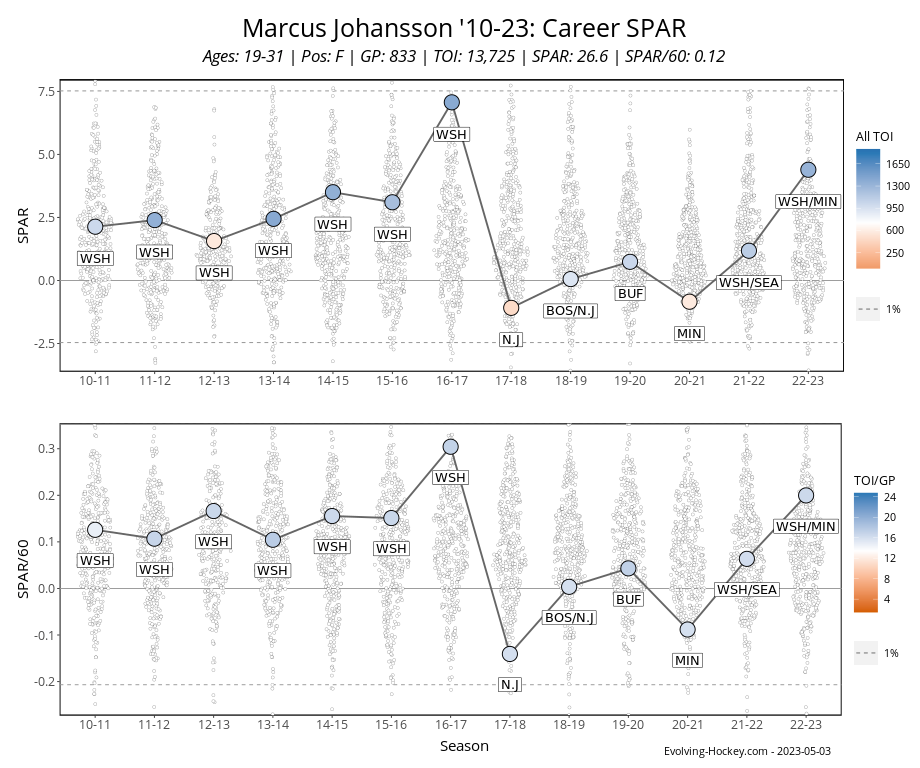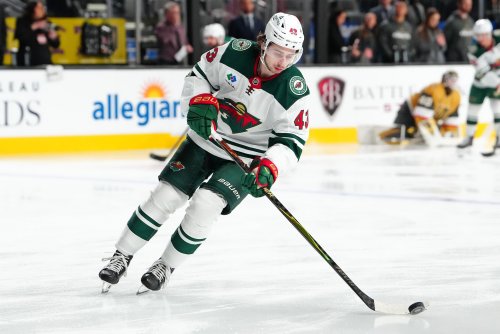
For a team that is going to have to rely on young players to get them through the next two years of cap hell, do you ever notice how this is a very old team?
The Minnesota Wild finished the 2022-23 season at an average age of 28.65, the seventh-oldest team in the NHL. Ahead of them were the usual suspects, either go-for-it-now contenders like the Tampa Bay Lightning and Colorado Avalanche, or the skeletons of dynasties past like the Pittsburgh Penguins and Washington Capitals.
Minnesota is older than they've ever been, and now they're even older. They have 16 players currently under contract for next year, with an average age of 29.25 (including 21-year-old Brock Faber). That's going to go down a touch if and when they re-sign key RFAs like Filip Gustavsson, Brandon Duhaime, and Calen Addison, and should youngsters like Marco Rossi or Sammy Walker make the team.
But the starting point for this team is pretty darn old, and they didn't get younger this week.
On locker room clean-out day, the Wild signed Marcus Johansson to a two-year deal carrying a $2 million cap hit. You can't say he didn't make a case for himself to return. Six goals and 18 points over 20 games is fabulous production, and it's clear he brought a puck-carrying element to the team that they often lacked. His 19 goals, 27 assists, and 80 games played were all his highest totals since the 2016-17 season.
And that's kind of the problem, right there. That season happened when he was 26. His latest contract is going to take him into his age-33 and 34 seasons.
When has that ever gone wrong for the Wild before?
Whoo boy, where do we start? First, t should be said that we can definitely find instances of this working out in Minnesota. Even on the roster right now, Jared Spurgeon and Mats Zuccarello are still playing at a high-to-elite level at their ages.
But even for star players, we've seen how quickly decline can hit a player in even their early 30s. Jason Pominville was a shell of his former self at 33. Dany Heatley was also spent at that age. Thomas Vanek didn't even make it there.
Historically, the Wild have done better with aging players than most. Eric Staal, Mikko Koivu, Zach Parise, Ryan Suter, and Brian Rolston are some names that come to mind as being productive in their early-to-mid 30s. But that history just doesn't extend to Bill Guerin's deals to older veterans.
Take a look at all these multi-year deals he's handed out to veterans. How many have worked out?
The Alex Goligoski one stands out as the Ur example of this kind of contract going wrong. Grabbing Goligoski originally, for a one-year, $5 million deal seemed like a smart, low-risk swing on a 36-year-old. Generally, there's no such thing as a bad one-year deal.
But Guerin doubled down on Goligoski after a half-season of thriving with Spurgeon, extending him through age-38. Is a $2 million cap hit technically reasonable for what he brings? You can argue that. Would the Wild probably rather have $2 million of flexibility? Probably, and they might just find themselves dumping the contract this summer.
Between Goligoski and Jon Merrill, who signed a three-year deal carrying him from ages 30 to 32 at around the same time Goligoski inked his latest contract, the Wild got a whopping two playoff games from the duo. Now, Merrill's cap hit is just $1.2 million. In a vacuum, $3.2 million isn't all that much. The problem is that the Wild's situation is far from a vacuum. Having that space free would represent an almost 50% increase in cap flexibility.
Think they could use it? Guerin might be able to flip one, or both, to find that extra wiggle room. He can't say the same for Marc-Andre Fleury, who he signed last year for a two-year, $3.5 million AAV pact that covered his age-38 and 39 seasons.
Gustavsson's emergence wasn't very foreseeable, but it's still another example of a multi-year deal to an aging player that's turned sour quickly. And right now, you can't deny it -- it hurts. Fleury carries a full-move clause and has no inclination to retire. The Wild are stuck with his cap hit, even if they wanted to roll with Gustavsson full-time while breaking 20-year-old Jesper Wallstedt into the NHL as a backup.
Fleury gave Minnesota a decent .908 save percentage in the regular season, mostly fattening up on lesser teams. The best-case scenario for next year is more of the same, except in a backup role to Gustavsson's starting minutes. But that's a job for an Alex Stalock, league-minimum type, not someone making $3.5 million. Especially on a team that is going to pinch pennies to sign Gustavsson to begin with.
Guerin has a ton of respect for Fleury; the future Hall of Famer was a former teammate. But that's gotta be cap space he'd rather have back.
Even the best of this bunch, Marcus Foligno, might find himself to be a luxury Minnesota simply can't afford. He's tough, he's physical, and he stands up for his teammates. But so does Duhaime, who's going to command about half of Foligno's $3.1 million cap hit.
Granted, that first year of Foligno's deal? Monster home run. The then-30-year-old scored a career-high 23 goals and 42 points while playing alongside Joel Eriksson Ek on the league's best shutdown line.
The following year, Guerin and Dean Evason broke up the band by trading away Jordan Greenway, who was much younger when he signed his instantly-regrettable contract, and promoting Eriksson Ek, respectively. He ended his season with seven goals and 21 points in a remarkably quiet year.
Is it bad luck or decline? We might not get to find out if the Wild feel the need to dump the final year of Foligno's contract, when he'll be 32.
All of that is to say that when Freddy Gaudreau and Johansson both sign multi-year deals taking them through age-34 in the span of a few weeks, there's reason to be skeptical, given Guerin's track record of evaluating these guys' future value.
You might peg Johansson as carrying the least risk of all these contracts. He had a very good season, the deal is two years rather than three or more, and the cap hit is a manageable $2 million. You've got to give Johansson some props for his season. Evolving Hockey's Standings Points Above Replacement model has him being worth 4.4 points to his teams, including over two in 20 games for Minnesota.
To put that in perspective, that's right around where Troy Terry (4.5 SPAR) and William Nylander (4.3) ended up this season, and he was tied for 62nd in the NHL.
It was also an out-of-nowhere career renaissance for the speedy winger. Over the previous five seasons, Johansson was the definition of a replacement-level player, with a SPAR of exactly 0.0. During that time, his range of outcomes hovered around being worth 1.2 and -1.1 SPAR. Not great!
But then he explodes. What do we make of his career arc?

Since 2007-08, we can find 32 players who've provided more than 4 SPAR for their teams at age-32. Of that group, 32 of them went on to play at 33 and 34. The good news for Johansson? 26 of them averaged 1.0 or more SPAR per season.
The bad news? Very few of those players seemed to fluke their way into that kind of season. For the data that we have, just one player, Danny Briere, averaged 1.0 SPAR per season before their big age-32 season. Everyone else averaged more, and often, way more.
It's just difficult to find a parallel to Johansson: someone who did essentially nothing for five years, then re-gained peak performance.
We would use Evolving Hockey's Similarity Scores to see how Johansson's comparables heading into this year fared in their age-33 and 34 seasons... except we can barely find any examples of his comparables playing at that age.
Between his three-year (from 2019-22) and six-year (2016-22) comparables, 24 NHL players show up as similar to Johansson. Only three of them (Mark Letestu, Valtteri Filppula, and Derick Brassard) had a season past age-31 with more than 1.0 SPAR. Filppula, Letestu, Brassard, and Bobby Ryan are the only ones to even play in the NHL beyond their age-32 season. Even in those cases, it wasn't pretty.
That's a lot of players like Bryan Little, Artem Anisimov, Paul Byron, Matt Read, Kris Versteeg, Brandon Sutter, and more who've washed out. Johansson managed to be an outlier this last season. Can he do it again? For the next two seasons?
It's a tough bet to make. At the most optimistic, you might say that maybe he's been injury-prone for five seasons, but now that he's healthy, he's back on track. Maybe. He missed significant time in four of the five previous seasons. But players tend to get less, not more durable as they enter their mid-30s. It'll be surprising to see Johansson suddenly put together an iron man streak.
Of course, this deal could work out. Johansson might be an outlier. But so many things are working against him. There's his age, there's his injury history, and there's the fact that his production in Minnesota was built on a nearly impossible-to-repeat 12.3% shooting by his teammates at 5-on-5. For context, that's even higher than his previous season high of 11.6, when he was on the peak Alex Ovechkin/Nicklas Backstrom/Mike Green Capitals.
The money isn't bad, and the Wild are a franchise that's going to need to go bargain-hunting. That's understandable. But Guerin's got one of the oldest teams in the league at a time they need to get younger, and locking up Johansson based on a 20-game hot streak through age-34 with a full no-trade clause is basically daring the Hockey Gods to pants you.
You can appreciate the difficult spot Guerin is in trying to keep this team competitive, and how it forces him to sign players who might have some warts. There's not going to be a perfect free agent target when you have $8 million of cap space. We understand that.
But the Wild have had just one way of addressing it: giving aging players term to keep their cap hit down. It's one thing to have a band-aid solution. However, if you're going to use a band-aid, use one that's going to be useful. Too many times, these solutions to patch up the team seem to dissolve the second the Wild jump into the pool. Buying the exact same brand of player isn't likely to succeed. But just like the coaches in the playoffs, the front office doesn't seem willing to make any adjustments to an underwhelming strategy.
Think you could write a story like this? Hockey Wilderness wants you to develop your voice, find an audience, and we'll pay you to do it. Just fill out this form.




.thumb.jpg.3818a5c4985e878d5ecaf2e7234883d8.jpg)

Recommended Comments
Join the conversation
You can post now and register later. If you have an account, sign in now to post with your account.
Note: Your post will require moderator approval before it will be visible.